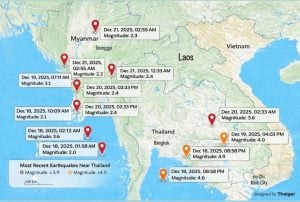BoT holds policy rate, predicts consistent economic growth

The Bank of Thailand has kept the policy rate steady at 2.5% during its latest meeting, rejecting governmental calls for a decrease. The decision, marking the third consecutive meeting with no change, is based on the Thai economy’s consistent growth, which has already exceeded 2023 levels.
Piti Disyatat, the secretary of the Bank of Thailand’s Monetary Policy Committee (MPC), stated that they predict a 2.6% growth in Thai GDP this year, aligning closely with the economy’s potential growth rate.
“The central bank foresees higher GDP growth for the first quarter of this year than the fourth quarter of 2023. Growth is expected to improve quarter-on-quarter throughout the year.”
Such an optimistic growth trajectory should contribute to GDP growth in the coming year, with the bank anticipating a 3% expansion in 2025. The National Economic and Social Development Council reported an economic growth of 1.7% in the final quarter of 2023 and 1.9% for the entire year.
In light of these positive trends, the MPC made a 5-2 decision yesterday to maintain the policy rate at 2.5%, with the two dissenting votes opting for a 0.25 percentage point cut. Piti emphasised that the MPC’s decision was grounded on a holistic view of the economy, considering both upside and downside risks.
“The 5-2 vote reflects differing perspectives, and the prime minister may hold an alternative viewpoint.”
Growth projections
The bank’s GDP growth projections for 2024 and 2025 took into account the government’s recent stimulus measures, including property incentives and a 500-billion-baht (US$ 13.6 billion) budget for the digital wallet scheme.
Piti identified tourism and private consumption as the main growth drivers this year, with foreign tourist arrivals in the first three months approximately matching the bank’s projection of 35.5 million for 2024, a significant increase from 28.2 million in 2023.
Government budget disbursements for fiscal 2024, slated for the fourth quarter of this year, are expected to stimulate the economy from late 2024 into 2025.
Despite this optimism, Piti acknowledged uncertainties surrounding the Thai economy, particularly concerning export recovery, government budget disbursement, fiscal stimulus measures, and monetary policies of major global economies.
Theerasate Prompong, an analyst at Maybank Securities Thailand, pointed out that the MPC’s decision to keep the rate steady was in line with about 70% of analysts’ predictions. He believed that the current rate is beneficial for maintaining economic stability and aiding monetary policy.
Theerasate also noted the Thai stock market and economy’s potential for growth, citing possible government stimulus measures, a robust export performance, and increased state infrastructure projects after the fiscal 2024 budget approval, reported Bangkok Post.
Therdsak Thaveeteeratham, executive vice president of Asia Plus Securities, posited that it would be surprising if the MPC decided to cut the rate before the Federal Reserve does, which is likely to happen after June. He stated that the Bank of Thailand’s decision to keep the policy rate constant was to mitigate baht fluctuation, despite inflation having been on a decline for several months.
Latest Thailand News
Follow The Thaiger on Google News:


























